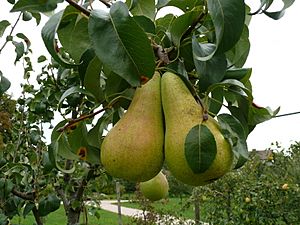Concorde (pear) facts for kids
Quick facts for kids Concorde pear |
|
|---|---|
 |
|
| Genus | Pyrus |
| Species | Pyrus communis |
| Hybrid parentage | Conference × Comice |
| Cultivar | Concorde |
| Origin | Kent, United Kingdom |
The Concorde is a special type of pear that first grew in England. It's a mix of two other popular pears: the Conference pear and the Comice pear. Because of this, it has good qualities from both its "parents."
Contents
How the Concorde Pear Was Created
The Concorde pear was developed by scientists at the East Malling Research Station in Kent, England. They started working on it in 1968 by carefully mixing pollen from the Conference and Comice pears.
After many years of testing, the Concorde was chosen as the best new pear in 1977. It was then made available for people to buy and grow in 1994. In 1993, it even won a special award called the Award of Garden Merit from the Royal Horticultural Society. This award shows it's a great plant for gardens.
How the Concorde Pear Tree Grows
The Concorde pear tree grows straight up and is quite strong. It starts to flower about five days later than its parent pears. Like the Comice pear, its fruit is ready to pick later in the season.
This tree can partly pollinate itself, which means it can produce fruit even if there isn't another pear tree nearby. It usually produces a good amount of fruit every year. Sometimes, it might even make too many pears! A great thing about the Concorde is that it often starts producing fruit about a year earlier than many other pear types.
What the Concorde Pear Fruit Is Like
The fruit of the Concorde pear is a mix of its parent pears. It has the long shape and crunchy texture of the Conference pear. But it also has the sweet taste of the Comice pear.
When the fruit is young, it looks greenish. As it gets ripe, it turns more yellowish. You might also notice some slight brown patches on its skin, which is called "russeting." This is normal for the Concorde pear.
See also
 In Spanish: Concorde (pera) para niños
In Spanish: Concorde (pera) para niños

